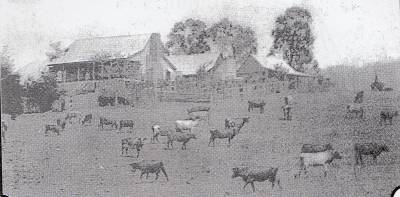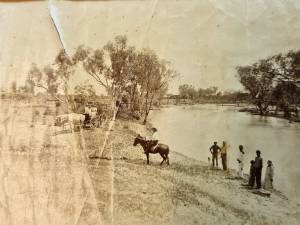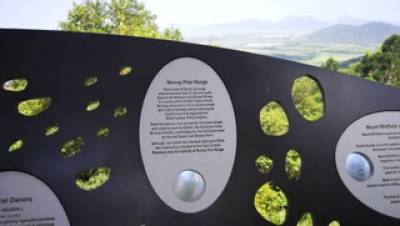Maroon
For information about Maroon, a Murray-Prior family home for 54 years, see sidebar.
Rathdowney
From 1865, the year after TLM-P acquired Maroon, he bought freehold land to the east of Maroon, on the northern bank of the Logan River, which he combined and named Rathdowney after his ancestors' Irish estate.1)
Acquiring Rathdowney was a group effort. TLM-P purchased 2,560 acres on 16 November 1868, while on 3 January 1876 his eldest son Thomas de M. M-P selected the homestead block of 640 acres under the 1868 Crown Land Alienation Act. Bill Kitson summarises, 'This Act allowed the Government to acquire half of the squatter's run either by resumption or voluntary surrender. This resumed half was then to be surveyed into blocks suitable for selectors looking for smaller agricultural farms. The run holder in return would receive a new lease on his half of the original run as well as other benefits. By this policy the Government was able to achieve their objectives of closer settlement with more people using the same area of land with the added benefit of an increase in rent.'2) The Act limited 'selections' of land to 640 acres and specified that the 'selector' had to have lived permanently on the land and farmed it, before its ownership was transferred to him. Wives and dependent children were ineligible to select land, in what proved to be a somewhat fruitless exercise to prevent what became known as 'dummying', i.e. paying trusted family members or employees to select then to transfer the land when ownership was confirmed. Eminent historian Ross Fitzgerald considers the squatters regarded selectors as intruders and manipulated land regulations to keep the newcomers out. As a result, 'many [squatters] resorted to “dummying” their runs (i.e., lodging land claims using the name of a family member or employee)… Most of the distinguished squatting families of the [Darling] Downs were involved….'.3) TLM-P and his eldest son were no exception. After the Rathdowney homestead block was confirmed as his, T de M. M-P immediately transferred the land to his father. TLM-P acquired more land under the selection act, another 640 acres in January 1880. As condition of acquiring the land, he had two witnesses swear that he had lived permanently there from the date of selection, February 1876. The witnesses were John Worrall and John Endersby, both stockmen in his employ.4)
While TLM-P joined his fellow squatters in circumventing the selection acts, he was sympathetic to the desire for people to own their own land. He was also aware that small holdings rarely provided a living for the selector. As he wrote in his 1888 diary: 'There seems to be a great land hunger. Now the more selections taken up the better but I can hardly see how they will make it pay - the labour and expenses of clearing is great; they deserve to succeed.'(entry for 5 July).
 An undated photo of Rathdowney. The home has since been demolished and another rebuilt in its place. In September 1979, when it was inspected under the selection act, TLM-P was said to have lived in the weatherboard house with its shingle roof, a detached slab kitchen and separate slab house for workmen. There was also a garden.5)
An undated photo of Rathdowney. The home has since been demolished and another rebuilt in its place. In September 1979, when it was inspected under the selection act, TLM-P was said to have lived in the weatherboard house with its shingle roof, a detached slab kitchen and separate slab house for workmen. There was also a garden.5)
TLM-P's stockman John Worrall didn't just act as witness, but himself selected 320 acres to the north of the Rathdowney property. His two witnesses who swore that he had lived there permanently, and thus was entitled to own the land, were John Endersby (the other of TLM-P's employees/witnesses) and Thomas de M. M-P. In August 1879 when the selection process was completed, John Worrall immediately transferred the land to TLM-P.6)
By 1880, the local council's rate book valued Rathdowney's buildings at £30.7)
In November 1884, TLM-P sold Rathdowney to William Collins and Sons.8) Nora wrote to Rosa Praed on 3 November 1884, that it was sold cheaply but a necessity: 27/6 per acre for 18,000 acres; £4 per head for 800 stores bullocks and £23 a head for 750 cows.'9) As Nora told Rosa Praed, if TLM-P were '20 years younger it would be madness to sell it yet the constant strain of hard labour is too much for him.'10) Rathdowney was subsequently subdivided and Rathdowney town developed there.11)
Aberfoyle
TLM-P worked this station with his son-in-law Jack Jardine. The nearest town was Aramac in the Barcaldine Region of Central West Queensland, on the tribal lands of the Iningai. The Queensland Horse And Cattle Brands Directory 12) notes that TLM-P and Jack Jardine applied for a brand (X2N) for horses and cattle on Aberfoyle on 5 November 1881. There is also a record of the same brand for Aberfoyle on 30 January 1896 13). In 1894, Murray-Prior and Jardine took out a licensed gate notice14)
The following photo of Torrens Creek, Aberfoyle is in the Murray-Prior papers in the National Library of Australia, MS 7801, Box 7. It is undated. [to do: other photos]

For more see entry on Lizzie Jardine under heading Matilda and TLM-P's children.
Murray Prior Range
This range of mountains, along with Mount Murray Prior, is in north Queensland near Cairns and the Indigenous community of Yarrabah. It was named after TLM-P.15) The following photo of the view towards the Murray Prior range was taken by Peter M-P in January 2020 from the Kuranda Range: 